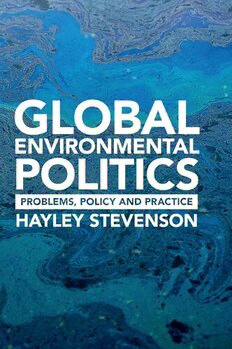Table Of ContentGlobal Environmental Politics
PROBLEMS, POLICY, AND PRACTICE
Concern about humanity’s impact on the planet has never been greater,
but what are the drivers of environmental change? This wide-ranging
introductory textbook outlines the competing explanations of why envir-
onmental problems occur and examines the different political approaches
takentoaddressthem.Adoptingacasestudyapproach,HayleyStevenson
enables students to gain a detailed understanding of how theories and
concepts are applied in practice. Diverse perspectives on a variety of
contemporary environmental challenges, from climate change to hazard-
ous waste, as well as various responses, from multilateral diplomacy to
consumer-focused campaigns, provide students with an in-depth under-
standingofthemeritsandlimitationsofdifferentformsofpoliticalaction.
Refinedonthebasisofclassroomfeedback,featuresincludetextboxes,key
points,aGlossaryofkeyterms,questions,furtherreadingsuggestions,and
supplementary online resources. This lively book is an essential resource
for advanced undergraduate and postgraduate courses on global environ-
mental politics and environmental policy.
Hayley Stevenson is Associate Professor in International Relations at the
Universidad Torcuato Di Tella, Argentina, and Reader in Politics at
the University of Sheffield. She is the author of Institutionalizing
Unsustainability: The Paradox of Global Climate Governance (2012) and
DemocratizingGlobalClimateGovernance(withJohnS.Dryzek,2014),and
co-editor of Traditions and Trends in Global Environmental Politics:
International Relations and the Earth (with Olaf Corry, 2017).
Global
Environmental
Politics
PROBLEMS, POLICY, AND PRACTICE
Hayley Stevenson
UniversityPrintingHouse,CambridgeCB28BS,UnitedKingdom
OneLibertyPlaza,20thFloor,NewYork,NY10006,USA
477WilliamstownRoad,PortMelbourne,VIC3207,Australia
4843/24,2ndFloor,AnsariRoad,Daryaganj,Delhi–110002,India
79AnsonRoad,#06–04/06,Singapore079906
CambridgeUniversityPressispartoftheUniversityofCambridge.
ItfurtherstheUniversity’smissionbydisseminatingknowledgeinthepursuitof
education,learning,andresearchatthehighestinternationallevelsofexcellence.
www.cambridge.org
Informationonthistitle:www.cambridge.org/9781107121836
DOI:10.1017/9781316344354
©HayleyStevenson2018
Thispublicationisincopyright.Subjecttostatutoryexception
andtotheprovisionsofrelevantcollectivelicensingagreements,
noreproductionofanypartmaytakeplacewithoutthewritten
permissionofCambridgeUniversityPress.
Firstpublished2018
PrintedintheUnitedKingdombyTJInternationalLtd.PadstowCornwall
AcataloguerecordforthispublicationisavailablefromtheBritishLibrary.
ISBN978-1-107-12183-6Hardback
ISBN978-1-107-54753-7Paperback
Additionalresourcesforthistitlecanbefoundatwww.cambridge.org/stevenson
CambridgeUniversityPresshasnoresponsibilityforthepersistenceoraccuracy
ofURLsforexternalorthird-partyinternetwebsitesreferredtointhispublication
anddoesnotguaranteethatanycontentonsuchwebsitesis,orwillremain,
accurateorappropriate.
Table of Contents
List of Figures page xi
List of Tables xii
List of Maps xiii
List of Boxes xiv
Preface xv
List of Abbreviations xviii
1 Global Politics and the Environment 1
Summary of Key Points 1
Introduction 2
State of the Planet 3
The Politics of Environmental Change 7
Outline of this Book 10
Discussion Questions 16
PART 1: WHY DO ENVIRONMENTAL
PROBLEMS OCCUR? 17
2 The Tragedy of the Commons 19
Summary of Key Points 19
Introduction 19
Core Assumptions Underpinning the ‘Tragedy’ 22
Human Beings areSelf-regarding and Short-sighted 22
‘The Commons’ are Unmanagedand Freely Accessible 22
Privatisation and Socialism are the Only Possible Solutions
toAvoidDegradation 23
Critiques and Corrections 25
Human Nature and theCommons 25
Historical Inaccuracies 26
Alternative Governance Options 27
The Global Commons 30
Whatare the Global Commons? 30
Managing the Global Commons 31
vi Contents
Conclusion 35
Discussion Questions 35
3 Population and Poverty 37
Summary of Key Points 37
Introduction 38
The Malthusian Renaissance 39
Solving the Population Problem 40
Trends in Population Growth 41
Is Population Control the Answer? 45
Is Poverty the Main Driver of Environmental Degradation? 46
The Environmental Kuznets Curve (EKC) 48
Questioning the Validity ofthe EKC 50
OutsourcingProduction and Pollution 52
Do Wealthier People Care More About the Environment? 53
Conclusion 56
Discussion Questions 57
4 Capitalism 58
Summary of Key Points 58
Introduction 58
The Contradictions of Capitalism 60
The Traditional Contradiction 60
The Ecological Contradiction 61
Capitalism’s Rifts 63
Alienation from Nature 64
Metabolic Rift 64
Ecological Rift 65
Ecological Imperialism 66
Over-consumption 68
Is Sustainable Capitalism the Solution? 70
Eco-socialism 72
Steady-state Economy and Degrowth 74
Conclusion 75
Discussion Questions 77
PART 2: RESPONDING TO GLOBAL ENVIRONMENTAL
PROBLEMS 79
5 Conflict and Securitisation Water Scarcity 81
Summary of Key Points 81
Contents vii
Introduction 82
Conflict and the Natural Environment 83
Conflicts Over Natural Resources 84
Water and Conflict 88
State ofthe World’s Water 88
Water Wars: Theory and Evidence 92
Weaknesses inInternational Cooperation 99
Securitising the Environment 102
Conclusion 105
Discussion Questions 106
6 Multilateral Diplomacy Sustainable Development 107
Summary of Key Points 107
Introduction 108
Multilateral Diplomacy 109
Environmental Multilateralism 112
The Environmental Movement 112
The Birth ofEnvironmental Multilateralism 112
North–South Tensions Emerge 114
The Golden Age ofEnvironmentalMultilateralism 116
EnvironmentalMultilateralismin the Twenty-first Century 117
Legal and PoliticalStatus ofMEAs 119
Sustainable Development 120
The Concept ofSustainable Development 120
Institutionalising Sustainable Development:
EarthSummit, 1992 122
RealityCheck: World Summiton Sustainable
Development, 2002 127
Facing Up to Unmet Promises:Rio+20 and Beyond 129
Conclusion 137
Discussion Questions 138
7 Transnational Governance Experiments Climate Change 140
Summary of Key Points 140
Introduction 141
Transnational Governance 142
Climate Change 145
The Science ofClimate Change 146
A ‘Wicked’PolicyProblem 147
Multilateral Cooperation on Climate Change 149
Transnational Climate ChangeGovernance 156
Governance Experiments 156
viii Contents
VirtuesofTransnational Climate Governance 162
Limitations ofTransnational Climate Governance 163
CoordinatingGovernance Experiments: NAZCA 164
Conclusion 165
Discussion Questions 166
8 Aid and Finance Deforestation 167
Summary of Key Points 167
Introduction 168
Aid and Financial Assistance 169
Multilateral Environmental Agreements 169
The Environmental Impact ofODA 171
Debt-for-Nature Swaps 176
Payment for Ecosystem Services 179
Finance and Deforestation 183
The Nature ofthe Problem 183
Drivers of Deforestation 185
GlobalForestryGovernance 187
Deforestation and the GlobalClimate Regime 189
REDD+ 191
Conclusion 195
Discussion Questions 196
9 Individualising Responsibility Unsustainable Consumption 197
Summary of Key Points 197
Introduction 198
Consumption and Its Environmental Impact 199
Mobile Phones 202
Fashion 204
Sustainable Consumption: Intergovernmental Initiatives 206
Private Sector and Civil Society Initiatives: Individualising
Responsibility 209
Voluntary Simplicity 210
Ecological Footprint 211
Carbon Neutrality 213
Eco-labelling 214
The Limits of Individualising Responsibility 215
Over-statingConsumer Sovereignty 216
‘Greenwash’ 217
Attitude–BehaviourGap 218
Depoliticising Unsustainability 219
Contents ix
Defending Individual Responsibility 220
Conclusion 222
Discussion Questions 223
10 Problem Displacement Hazardous Substances 224
Summary of Key Points 224
Introduction 225
Toxic Elements 226
Mercury 228
Lead 229
Cadmium 231
Dioxinsand Dioxin-like Substances 232
Global Governance of Chemicals and Hazardous Waste 233
Fragmented Global ChemicalGovernance: Overlaps and Gaps 240
Displacing the Problem 242
The Khian Sea 243
EnvironmentalInjustice 244
Understanding Environmental Injustice 245
The Basel Convention: Weaknessesand Limitations 248
E-waste Dumping or Much Needed Trade? 251
Conclusion 253
Discussion Questions 254
11 Resistance and Localisation Unsustainable Agriculture 256
Summary of Key Points 256
Introduction 257
Social Movements and Resistance 258
Globalisation and the Environment 260
Agriculture and the Environment 261
The Riseof Modern Agriculture 262
The Relationship Between the Environment and Agriculture 267
Resisting Unsustainable Agriculture 272
Demanding Sustainable Agriculture 273
Practising Sustainable Agriculture 275
Brazil and the Landless Rural Workers Movement 276
Campesino aCampesino, Central America 277
Cuba and Organic Agriculture 278
Questioning Agroecology 279
Conclusion 280
Discussion Questions 281

